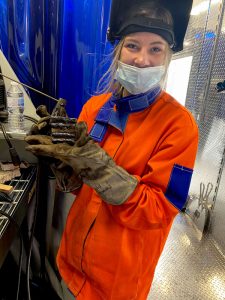Building trades trainers are increasingly crafting recruitment drives that involve pre-apprenticeship programs targeting underrepresented groups partly as a response to societal pressures for a diversified workforce.
But the recruitment shift is also out of necessity.
“We’ve exhausted that white male demographic,” says Adam Bridgman, provincial carpentry training co-ordinator with the Carpenters’ District Council of Ontario.
“It wasn’t that we actively went out of our way to just hire white guys for the last 40, 50, 60, 100 years.”
But many young white males came to the trades to follow in the footsteps of their fathers.
That is not happening today and the Carpenters’ locals in Ontario see a growing need for women, people of colour and other minorities to help meet future workforce needs, Bridgman says.

A case in point is in Ottawa where Carpenters’ Local 93 is running a pre-apprenticeship program for Indigenous people, women and newcomers. Called WIN IT, it is tailored to work in the ICI sector, specifically concrete formwork and steel stud framing (two areas of need), the latter done in partnership with Local 2041.
“They (students) are given real job-like experiences, what they will see as a carpenter in the ICI industry,” says Jon Baron, Local 93’s training co-ordinator.
Of the 10 participants in the first cohort earlier this year, seven were woman, six of whom signed on as apprentices, says Baron.
“We didn’t anticipate this much success.”
The pre-apprenticeship course includes an introduction to framing, scaffolding, formwork, welding and stationary power tools.
Virtual reality equipment accelerates learning, giving students virtual construction site experience.
“It takes days off the learning curve,” he says.
Health and safety training such as working at heights, power elevated work platforms, forklift operator and first aid/CPR is also covered.
Baron says while most of the participants have been young at 18 to 20 years old, most are “very motivated. They want to be here, they ask a lot of questions.
The training and materials costs of WIN IT are free to students. The Local receives funding through the province’s Skills Development Fund.
Baron says the goal at Local 93 is to train 36 apprentices in three cohorts a year. It might not seem like a lot, but he believes the merits of a career in the trade could spread through word of mouth quickly to other eligible candidates.
“I see a huge benefit to the program,” says Baron. “I’d say it is working better than some others I’ve seen, so I hope that is enough to help us secure some more funding.”
In Thunder Bay, Carpenters’ Local 1669 has partnered with Anishinabek Employment and Training Services (AETS) to run two pre-apprenticeship courses geared to First Nations residents, one for carpentry and the other for drywall.

Evan Reid, president of Local 1669, says while traditionally many pre-apprentices fail to seek jobs in the trades, the Local has had more success with students in the past year partly because they get more attention in the smaller (by half) classes. This is a requirement under health and safety protocols brought on by the pandemic.
Students are taught the basics of a foundation in each trade over a 10-week period, with an additional two weeks provided for instruction in welding.
While Reid says a number of the students are from remote, fly-in locations and most are under 30 years old, usually about a quarter of the participants in each cohort are in their 30s and even 40s.
One of those is 32-year-old Ron Fox, who had no experience in construction prior to signing up for the drywall pre-apprenticeship course. Fox had to travel from Big Trout Lake, 600 kilometres north of Thunder Bay, for the course.
Adjusting to city life wasn’t easy and the course work was a challenge, he says.
“I had no idea what to expect but I have really liked it.”
Two weeks after graduating, Fox started pulling 12-hour shifts, installing steel studs and drywall at the expansion of the Kenora Jail for Integral Construction, a contractor that wants to hire him on a full-time basis for work on its next project in Ottawa.
Fox would recommend pre-apprenticeship to anyone who thinks they might have an aptitude for construction.
“Growing up, my late grandpa Bob Fox tried multiple times to get me into carpentry, but I wasn’t mature enough to understand it. Now that I am older, I finally get what carpentry is capable of for me. Carpentry is life.”











Recent Comments
comments for this post are closed